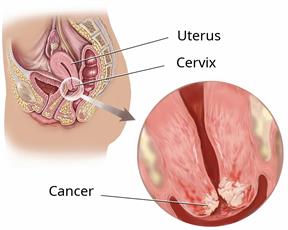Cervical Cancer

The cervix is the lowest part of the uterus. It connects the vagina and the uterus.
Cancer happens when cells become abnormal and start to grow out of control. Types of cervical cancer include:
Squamous cell carcinoma. This is the most common type. This cancer starts in the cells that line the surface of the cervix.
Adenocarcinoma. This cancer starts in the gland cells that line the cervix.
Adenosquamous carcinoma or mixed carcinoma. This occurs less commonly and may have features of both squamous cell and adenocarcinoma.
What are the causes?
Most cervical cancers are caused by a virus called human papillomavirus (HPV).
What increases the risk?
The following factors may make you more likely to develop this condition:
Sexual history
- You have certain things in your sexual history, such as:
Having multiple sexual partners or having one sexual partner who has had many sex partners.
Not using condoms correctly every time you have sex.
Having chlamydia.
Having been sexually active before 18 years old.
Using birth control pills for a long time.
Having had multiple full-term pregnancies.
Family or genetic factors
-
Your mother took a medicine called diethylstilbestrol (DES) while pregnant with you, causing you to be exposed to this medicine before birth.
-
Your mother or sister had cervical cancer.
Other risk factors
-
You are between 35-45 years old.
-
You have had cancer of the vagina or vulva.
-
You smoke or regularly breathe in secondhand smoke.
-
You have a weakened body defense system (immune system).
-
You have a history of abnormal cells (dysplasia) of the cervix.
What are the signs or symptoms?
There are no symptoms during the early stages of cervical cancer. Once the cancer is in the cervix and spreads to nearby tissues, symptoms may include:
- Abnormal vaginal bleeding, such as:
Bleeding after sex, douching, or having a pelvic exam.
Bleeding after menopause.
Bleeding or spotting between periods.
Periods that are longer or heavier than usual.
Abnormal or increased vaginal discharge.
Pelvic discomfort, pain during sex, or unexplained back pain that will not go away.
An abnormal Pap test.
How is this diagnosed?
This condition is diagnosed based on your medical history and a physical exam, which includes a pelvic exam and Pap test. Your health care provider may also do:
A colposcopy. A microscope is used to check the cells of the cervix, vagina, and vulva.
A cervical biopsy. Small samples of tissue from the cervix are removed and checked under a microscope. A type of cervical biopsy that may be done is a cone biopsy. Multiple layers of cervical tissue are removed and tested.
If cervical cancer is found, your provider may order imaging studies such as:
How is this treated?
If cervical cancer is found, it will be staged. Staging assesses tumor size and if and where the cancer has spread.
Treatment for this condition depends on the cancer stage and may include:
Cone biopsy to remove the cancerous tissue. This is usually done when cervical cancer is found in the early stage.
Removing the uterus, cervix, upper vagina, lymph nodes, and nearby tissue. The ovaries may be left or removed.
Surgery, chemotherapy, and radiation therapy. These may also be done individually or in combination.
Immunotherapy. These are substances that strengthen your immune system's fight against cancer or infection. They may be used with medicines for cancer (chemotherapy). This is usually done for cervical cancer that has spread to other parts of the body (metastasized).
Follow these instructions at home:
General instructions
-
Take over-the-counter and prescription medicines only as told by your provider.
-
Do not use any products that contain nicotine or tobacco. These products include cigarettes, chewing tobacco, and vaping devices, such as e-cigarettes. If you need help quitting, ask your provider.
-
Do not have sex until your provider says it is safe.
-
Use a condom every time you have sex.
-
Consider joining a support group with others who have a cervical cancer diagnosis.
-
American College of Obstetricians and Gynecologists:
acog.org
-
-
Contact a health care provider if:
-
You have pelvic pain or pressure.
-
You have leg or back pain.
-
You have abnormal vaginal bleeding or discharge.
-
You lose weight.
-
You cannot pee (urinate).
-
You have blood in your pee.
-
You have blood in your poop (stool).
-
You develop severe back, stomach, or pelvic pain.
This information is not intended to replace advice given to you by your health care provider. Make sure you discuss any questions you have with your health care provider.
